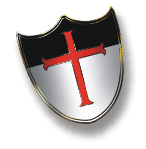 Welcome to a new feature at www.michaelspradlin.com called Templar Tuesday. Each week, I’ll be sharing some aspect of the history of the Knights Templar, the Crusades as well as information on the upcoming publication of the second book in The Youngest Templar Trilogy, The Youngest Templar: Trail of Fate on sale October 29th, 2009.
Welcome to a new feature at www.michaelspradlin.com called Templar Tuesday. Each week, I’ll be sharing some aspect of the history of the Knights Templar, the Crusades as well as information on the upcoming publication of the second book in The Youngest Templar Trilogy, The Youngest Templar: Trail of Fate on sale October 29th, 2009.
The content for Templar Tuesday is provided in partnership with www.templarhistory.com, in my opinion the best website on history of The Knights Templar in existence. I invite you to visit templarhistory.com for fascinating articles, reviews and even great Templar gifts. Make sure to save templarhistory.com in your favorites!
News about The Youngest Templar: Trail of Fate.
The Youngest Templar Trilogy continues to be something of an international sensation. Rights to the trilogy have just been sold in Australia/New Zealand and we just made a deal with a publisher in the United Kingdom for a British edition. Check the Templar Page to see all of the various covers from the foreign editions.
And check back soon for a new excerpt from Trail of Fate.
Templar Trivia
One of the most common questions I get from readers is the origin of the so-called Templar ‘Battle Cry’ Beauseant! Like most words and terms its true meaning has changed over time. Now it is generally accepted that the term means “Be Glorious!” and was shouted out by Templar Knights as they rode into battle. But originally the term referred to the black and white banner Templar Knights carried as a standard as they prepared to meet their enemies on the battlefield.
Here is an excerpt from an article that explains some of the history and background of the term:
–
Symbolically, the black section is said to have depicted the sins of the secular world that the Templar knights had chosen to leave, while the second section was white – depicting the purity that the order offered them – a sort of transformation from darkness to light.
Despite many depictions of the banner in later day paintings, the battle standard was not such that it drooped down on its pole. Rather, the banner was held in place top and bottom by two poles so that it did not require a breeze to be seen by the Templars and their enemies.
So important was the view of the flying Beauseant that, before a battle, the Marshal would select ten Templars to protect him and the banner. If the Marshal was killed during fighting, the Commander of Knights would take the banner so that it may fly above the battle for all to see.
 This created somewhat of a catch twenty -two situation, for as long as the Beauseant flew the Templars must fight on and as long as the Templars fought on, the Beauseant must fly.
This created somewhat of a catch twenty -two situation, for as long as the Beauseant flew the Templars must fight on and as long as the Templars fought on, the Beauseant must fly.
The purpose of the banner was to serve as a rallying point for the Templars. One of the Order’s tactics during battle was the heavy horse charge. This often caused the Templars to be separated from one another. As such, the flying Beauseant would allow them to easily regroup in order to continue the attack.
–
Also, if you are interested in learning about the history of The Knights Templar in a fun and unique way, check out Outremer: The Saga of the Knights Templar the Knights Templar Comic Book!





